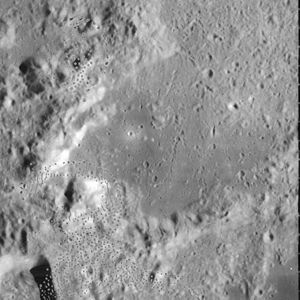Alexander (crater)

Lunar Orbiter 4 image
(spots are blemishes on original image) |
|
| Coordinates | 40°18′N 13°30′E / 40.3°N 13.5°ECoordinates: 40°18′N 13°30′E / 40.3°N 13.5°E |
|---|---|
| Diameter | 81 km |
| Depth | 1.3 km |
| Colongitude | 347° at sunrise |
| Eponym | Alexander the Great |
Alexander is a lunar crater-like feature in the rugged surface to the north of Mare Serenitatis. It lies to the south-southwest of the prominent crater Eudoxus, and to the east-northeast of Calippus. Also to the north is the smaller crater Lamèch.
The Alexander formation has been so heavily worn and distorted with the passage of time that it now resembles little more than a lowland region enclosed by rugged ranges. The rim segments lie along the northwest, west, and south sections of the crater, while the eastern side stands open to the surrounding surface. The surviving walls are nearly rectangular in form, with the most prominent mounts in the northwest.
The crater floor is more smooth and has a darker albedo in the western half, and gradually grows lighter and more impacted toward the east. There are no craters of significance within the perimeter of this formation, although there are tiny craterlets aplenty in the rougher eastern section.
From that location the Earth would appear in the lunar sky at under 50 degrees above the horizon towards the south, in the east, it is seen more than 13 degrees towards the east.
By convention these features are identified on lunar maps by placing the letter on the side of the crater midpoint that is closest to Alexander. Alexander A, B and C are all in the east with the first two located next and the other in the southeast and Alexander K is further east.
...
Wikipedia
